Greetings! 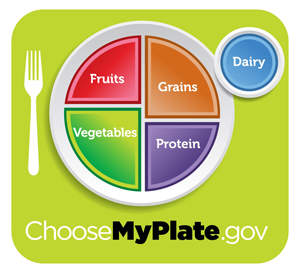 This is our second Cooking with Kaye to discuss the newly introduced USDA Food Plate that replaced the 19-year-old Food Pyramid last month. Today we are discussing grains and the role they play in our diet after weight loss surgery. In the early months and even years following surgery a goodly number of patients report difficulty and discomfort when eating rice, pasta, and bread. "It just feels like a big ball is stuck" is a common description when we test drive pasta or rice after surgery and it does not go well. One reason we struggle with pasta or grains is that we do not chew them as well as we do other nutrients like solid protein. They are soft and down they go before being broken down by mastication. We can compound the problem by eating ahead of our pouch. By that I mean without realizing it, because the food is soft and goes down easy, we eat more volume than our pouch can hold. The warmth of the stomach, the gastric juices, and the partially chewed pasta actually do churn into a lump of sorts and in my experience it is painful to be in this predicament. It took me several bad "test drives" to figure out that pasta, rice, or bread should not be a featured course on my plate: they should be used as a condiment complimenting lean protein with sides of vegetables and fruits. On page 85 of Day 6: Beyond the 5 Day Pouch Test I share this practice, "I suggest treating starch, especially pasta, as a condiment. Here's how: onto a small salad plate measure a 1/2 to 3/4 cup serving of meat sauce. Top with a 1/4 cup serving of pasta or starch and sprinkle with 1 tablespoon of cheese." In other words, serve the spaghetti and meatballs upside down. Grains, particularly whole grains, have many nutritional benefits. As the new Food Plate guidelines gently tell us we should select grains marked "whole" and avoid eating refined grains which have been robbed of fiber and nutrients. There is a certain sensibility about it that is easy to talk about but more challenging to do when we are out there on the front lines of life. Today I have prepared some recipes for you to try. The exact recipes are not as import as the methods behind them. Learn to select grains and make them a part of your meal in salads or tasty side dishes flavored with vegetables, herbs, fruit, and healthy oil. Most of us became over weight because we enjoy food. I think we can also manage our weight AND enjoy food when we select beautiful balanced foods to fill our plate. CHEERS! Kaye Bailey Read Part 1: Cooking with Kaye USDA Food PlateJoin me and others in the LivingAfterWLS Neighborhood - Your safe haven circle of friends.
Day 6: Beyond the 5 Day Pouch Test by Kaye Bailey This best selling book includes 66 recipes to support your weight loss surgery lifestyle. The family friendly recipes are affordable and make good meals quick and easy to put on the table. The highly acclaimed text of Day 6 gently guides you along your weight loss surgery journey in Ms. Bailey's generous spirit of compassion and belief in others. Get your copy today and never again travel this journey alone. "This is the book I wish I had read before having surgery in the first place - it would have made all the difference in my success or failure." -- Alyce Pittaway, Laparoscopic GastricBypass 2002 List Price: $29.95 Sale Price: $25.95 - BUY NOW(Use coupon code GRILL2011 & Save $3 More!)SHOP LivingAfterWLS General Store |
 A Healthy Plate: A Healthy Plate:
Include the Five Sensations of Taste
| 
by Kaye Bailey
At right is a dinner I prepared for our family last week modeled after the new USDA Food Plate. Clockwise from the top you see oven roasted broccoli with yellow peppers, orange slices, our featured recipe Scallops (and shrimp) with Chipotle-Orange Sauce and Yellow Pepper Rice. Not only are the colors vibrant, in fruits and vegetables they indicate foods rich in vitamins and nutrients. My WLS plate was sparse with each element being served in half-portion size. Yet I still left food on the plate --a few bites of grain and a floret or two of broccoli-- happily satisfied but not stuffed.
Scientifically speaking from the point of view of taste this plate provides all five sensations of taste that humans can detect: sweetness, bitterness, sourness, saltiness, and umami (popularly referred to as savoriness). When a meal provides all five sensations of taste it is believed post-meal taste cravings are eliminated. Think about a snack or meal that is overly sweet or salty. After eating it a craving will soon follow for one of the other basic tastes: sweet is followed by salty. As you look at recipes or menu selections try to find how many of the five tastes will be met in that meal. The more tastes we satisfy the less desire we will have later for just a little something extra. This plate comes from one of my favorite books: Cooking Light: The Essential Dinner Tonight Cookbook. I have made this meal from page 200 many times using lean chicken or pork in place of the scallops. The chipotle-orange sauce is a perfect balance of sweetness, saltiness and savoriness that can be heated up with more chipotle or cooled down with less. The meal comes together quickly and is lovely to serve your close family members or those who are lucky enough to be guests at your table. I hope you enjoy! 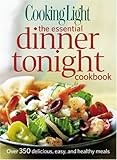
Cooking Light The Essential Dinner Tonight Cookbook: Over 350 delicious, easy, and healthy meals
by Editors of Cooking Light Magazine by Oxmoor House
Hardcover

List Price: $29.95
Our Price: $17.60
Buy Now
|
 Scallops with Chipotle-Orange Sauce Scallops with Chipotle-Orange Sauce
| 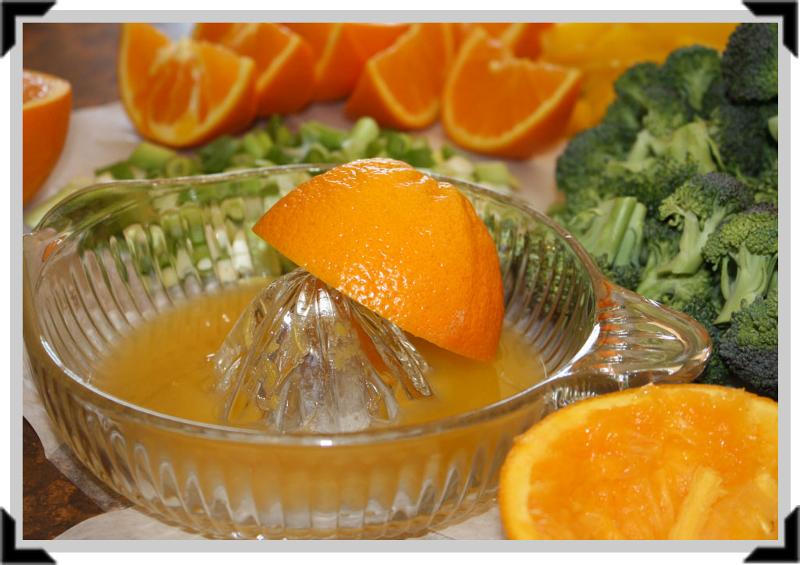
Fresh is Best When a recipe calls for a small amount of citrus juice it is often more affordable to buy one or two oranges and squeeze it yourself rather than fresh 100% juice off the shelf or frozen concentrate. Use a microplane tool to zest the rind of the orange and add to the sauce for an extra kick of sweet orange flavor. Ingredients: 2 tablespoons butter, divided cooking spray 1 1/2 pounds large sea scallops (thawed, patted dry if using frozen) 1/2 teaspoon sweet paprika 1/4 teaspoon salt, divided 1/2 cup fresh orange juice 1 tablespoon finely chopped canned chipotle chile in adobo sauce 1/4 cup chopped green onions Directions: Melt 1 tablespoon butter in a large skillet coated with cooking spray over medium-high heat. Sprinkle scallops with paprika and 1/8 teaspoon salt; add to pan, and cook 3 minutes on each side or until browned. Remove from pan; keep warm. Add juice and chile to pan, scraping pan to loose browned bits. Bring liquid to a boil; cook until reduced to 1/4 cup (about 1 minute). Add 1 tablespoon butter and 1/ teaspoon salt to pan; stir with a whisk. Serve sauce over scallops; garnish with green onions. Serves 4 USDA Portions of 4 ounces scallops, 1 tablespoon sauce, 1 tablespoon green onions). Per serving: 218 calories, 29g protein, 8g carbohydrate, 7g fat, 488mg sodium. ( Note: In the meal I prepared and shown in the photos I double the recipe and included 1 pound of medium shrimp to feed a larger number of people. The shrimp also were great in this preparation. This really is a versatile recipe!)Serve with Yellow Pepper Rice or one of the other rice dishes and Oven Roasted Vegetables.  
Microplane 40020 Grater/Zester
by Microplane
Kitchen

List Price: $12.95
Our Price: $9.21
Buy Now
|
LivingAfterWLS Resources
| Home Page - Blog - Kitchen - Library - Neighborhood
5 Day Pouch Test - 5 Day Pouch Test Blog
LivingAfterWLS General Store Publications - Seasonings - Soup Mixes - Fun Stuff

Turn up the Heat on the Grill!
Enter Coupon Code: GRILL2011 at checkout
Save $3 off any $20 order & get recipe & seasoning blend sample to make some crazy good barbecue sauce!
CODE: GRILL2011
Shop Now |
Grains Play Starring Role in Salads
| 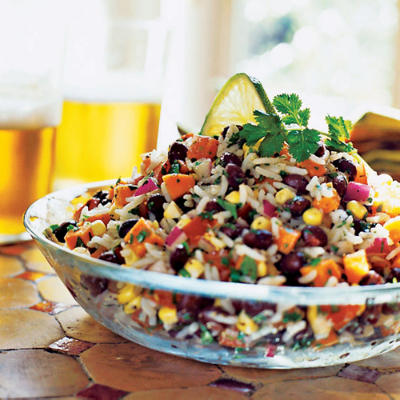
 I grew up like most Americans putting a scoop of quick rice or mashed potatoes on my plate and dousing it with butter or gravy or both. It was only after weight loss surgery that I learned grains could be an ingredient in salads of all things. Nutritionally this makes sense. When the salad is made of vegetables and flavored with healthy olive oil and fruit juice our bodies are better able to absorb the variety of nutrients in the dish. In addition the variety of texture and flavor in a simple grain enhanced salad brings us to satiation with a smaller serving. Here are three of my favorite recipes where grains play a starring role in salads. Follow them exactly or take-up the technique to create your own healthy and delicious masterpiece. Black Bean Salad with Quinoa One of the best ways for weight loss surgery patients to enjoy whole grains is including them as an ingredient of a salad Including whole grains as a salad ingredient is a terrific way for weight loss surgery patients to enjoy them without exceeding an appropriate portion. This salad includes Quinoa -- a nutty tasting whole grain that is less filling than pasta or other grains -- citrus juice, fresh tomatoes and peppers and canned black beans. It is beautiful on the plate and satiates all manner of cravings. Serve 1/3 cup per weight loss surgery portion with a lean grilled meat and orange slices or tomato slices for a complete balanced meal. Ingredients: 1/3 cup Quinoa, dry 1 cup cold water 1 teaspoons olive oil 4 teaspoons fresh lime juice 1/4 teaspoons ground cumin 1/4 teaspoons ground coriander 1 tablespoons fresh cilantro , finely chopped 2 tablespoons chopped scallions , minced 1 (15-ounce) can black beans, rinsed and drained 2 cup chopped tomato 1 cup chopped red bell peppers 2 teaspoons Chile Peppers, finely minced 1 pinch black pepper 1 pinch salt 1 medium limes, sliced Directions Rinse the quinoa well in a sieve under cool running water. In a saucepan, bring the water to a boil, add the quinoa, cover, and simmer on low heat, about 10 to 15 minutes. Allow to cool for 15 minutes. Meanwhile, in a large bowl, whisk together the oil, lime juice, cumin, coriander, cilantro, and scallions. Stir in the beans, tomatoes, bell peppers, and chiles. Add the cooled quinoa, and salt and pepper to taste, and combine thoroughly. Cover and refrigerate until ready to serve; serve chilled. Garnish with lemon or lime wedges. Per 1/3 cup serving: 95 Calories; 16g carbohydrate; 5g protein, 1.4 g fat. Almond Rice This quick recipe features cooked rice with slivered almonds and almond liqueur and topped with fresh green onions. A 1/4-cup WLS size serving is 75 calories, 12g carbohydrate, 2g proteinl and 2g fat. This dish is particularly delicious when served with protein flavored with a sweet and savory preparation that includes a sauce to be lightly spooned over the rice. Remember to measure your portion. A typical serving size is 1/2 cup. Ingredients: 2 teaspoons olive oil 1/2 cup slivered almonds 1 tablespoon amaretto liquer or 1 teaspoon almond extract 2 cup cooked white rice or cooked brown rice 1/4 cup freshly chopped green onion Directions: 1 Heat oil in skillet, add almonds, and saute just until golden. Add liqueuer and rice to skillet. Stir until heated. Add onions; stir to mix well. Serve warm. Chickpea and Couscous Salad Chickpeas are legumes with a wrinkled texture and slightly larger than a sweet green pea. They are available canned year round and are found in humus and Indian and Mediteranean cooking. Chickpeas are a good source of vegetable protein. Adding them to this rice salad improves the nutritional content, the texture and the taste making one great side dish. Ingredients: 4 ounces couscous 2 teaspoons olive oil 1 small white onion, chopped 2 medium garlic cloves, minced 4 ounces chickpeas, rinsed and drained 1/4 cup chopped parsley , minced 2 tablespoons fresh lemon juice 1 teaspoonssalt 1/2 teaspoons black pepper Directions Boil 1 1/2 cup of water and stir in couscous. Remove from heat and let stand for 5 minutes. In a separate skillet, heat oil, add onion and garlic. Cook on medium heat stirring frequently until golden brown. Mix chickpeas and 1 tablespoon of water, cooking it until water evaporates. Mix everything together stirring in couscous, parsley, lemon juice, salt, and pepper. Serve warm. For weight loss surgery eating measure a 1/2 cup serving and enjoy one bite of salad to one bite of lean protein taking time to chew and enjoy each bite slowly. Follow this pattern and stop one bite short of feeling full. A 1/2 cup serving provides 175 calories, 32g carbohydrate, 5g fat, 6g protein. LivingAfterWLS Salad Recipes
|
| USDA Ditches Food Pyramid for a Healthy Plate |
|
From WebMD
By Daniel J. DeNoon
WebMD Health News
Reviewed by Laura J. Martin, MD
 June 2, 2011 -- A colorful four-part plate, with a side dish of dairy, has replaced the 19-year-old food pyramid as the icon of the new U.S. Dietary Guidelines. 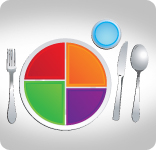 The new icon, called "My Plate," is split into four sections -- red for fruits, green for vegetables, orange for grains, and purple for protein -- with a separate blue section for dairy on the side. Agriculture Secretary Tom Vilsack unveiled the icon at a news conference today. He said the food pyramid was "simply too complex to serve as a quick and easy guide for American families." At the news conference, first lady Michelle Obama praised My Plate as "a wonderful, kid-friendly tool" that's practical for busy families. "What's more simple than a plate?" she asked. "I'm confident that families will find this useful. They can start using this today." The Obamas are already doing so. "Trust me: We are implementing this in our household," Obama said. The icon represents more than the currently recommended diet. It's part of a drastic change. The old plan was to provide information. The new plan is to actively change American eating behavior, using all the tools of modern persuasion. "The centerpiece of the program is this next-generation food icon," Robert C. Post, PhD, deputy director of the U.S. Department of Agriculture (USDA) center for nutrition policy and promotion, tells WebMD. "The icon is the visual cue to get to online resources, to online media, and to unified nutrition messages from public- and private-sector efforts." Expect a barrage of messages and reminders from the food industry, nutrition gurus, chefs, schools, nonprofit agencies, and every government agency with anything at all to say about nutrition or health. Twitter feeds, Facebook pages, and blogs will trumpet the healthy diet program. Eating is only half the picture. Michelle Obama's Let's Move program will take the lead in motivating Americans to get more exercise. (Get a printable image of the new food icon with options for your meals. LINK)
|
I wish you the best health and happiness LivingAfterWLS!
Cheers!
Kaye Bailey
LivingAfterWLS, LLC
|
|
|
|
|
|
| "The centerpiece of the program is this next-generation food icon. The icon is the visual cue to get to online resources, to online media, and to unified nutrition messages from public- and private-sector efforts."
--Robert C. Post, PhD
Deputy Director of USDA
ChooseMyPlate.gov |
| LivingAfterWLS General Store
Celebrate Grilling Season!
Coupon Code: GRILL2011
Save $3 & Get Free Recipe with Seasoning Sample to make
Delicious Barbecue Sauce!
Total Value: $3.95!!
Minimum purchase $20
May 30-June 30
Enter code at checkout:
GRILL2011
|
| |
Shop Now
|
A New Look at Grains from USDA
|
 | | USDA Grains Icon |
With the introduction of the USDA's new food plate we are seeing a different focus on grains. Historically we have labeled them whole grains or processed grains. The new guidelines have kept the term whole grains but now call processed grains refined grains.
In the old Food Pyramid (which is now retired) grains held the bottom tier of the pyramid suggesting an intake of 6-11 servings from that group a day. The new recommendations for grain intake vary depending upon age, sex, and level of physical activity. Approximate servings of grain for women are 5-6 ounce equivalents and men 6-8 ounce equivalents. In general, 1 slice of bread, 1 cup of ready-to-eat cereal, or ½ cup of cooked rice, cooked pasta, or cooked cereal can be considered as 1 ounce equivalent from the Grains Group.
Whole Grains: amaranth, brown rice, buckwheat, bulgur (cracked wheat) millet, oatmeal, popcorn, whole wheat cereal flakes, muesli, rolled oats, quinoa, sorghum, whole grain barley and cornmeal, whole rye, whole wheat bread, pasta, crackers, tortillas, and wild rice. Refined grains: cornbread, corn tortillas, couscous, crackers, flour tortillas, grits, noodles, pasta, pitas, pretzels, ready-to-eat breakfast cereals, white bread, rolls and buns, and white rice. Most of these products are made from refined grains. Check the ingredient list for the words "whole grain" or "whole wheat" to decide if they are made from a whole grain. Some foods are made from a mixture of whole and refined grains.
The advice is to make at least half of all the grains we eat whole grains. We should eat sparingly refined grains which are milled, a process that removes the bran and the germ. Milling produces ingredients like white flour, degermed cornmeal and white rice which have a finer texture making them a better ingredient for noodles, pasta, breads, and sweets. Unfortunately the milling removes the dietary fiber, iron, and many B vitamins taking the nutritional value out of an originally healthy food. Learn more about Grains at ChooseMyPlate
|
| Social Connections |  | |
We are all in this together!
Let's connect!




|
|
Tips to help you eat whole grains
| 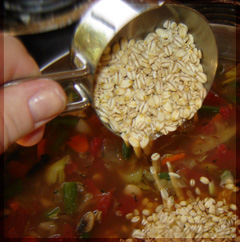 | Provided by USDA ChooseMyPlate
To eat more whole grains, substitute a whole-grain product for a refined product - such as eating whole-wheat bread instead of white bread or brown rice instead of white rice. It's important to substitute the whole-grain product for the refined one, rather than adding the whole-grain product.
For a change, try brown rice or whole-wheat pasta. Try brown rice stuffing in baked green peppers or tomatoes and whole-wheat macaroni in macaroni and cheese.
Use whole grains in mixed dishes, such as barley in vegetable soup or stews and bulgur wheat in casserole or stir-fries.
Create a whole grain pilaf with a mixture of barley, wild rice, brown rice, broth and spices. For a special touch, stir in toasted nuts or chopped dried fruit. Try these recipes in this newsletter: Grains Play a Starring Role in Salads
Use whole-grain bread or cracker crumbs in meatloaf.
Try rolled oats or a crushed, unsweetened whole grain cereal as breading for baked chicken, fish, veal cutlets, or eggplant parmesan.
Try an unsweetened, whole grain ready-to-eat cereal as croutons in salad or in place of crackers with soup.
|
LivingAfterWLS
Bulletin Board
|
|
Now in the Fourth Printing!  A Collection of Neighborhood Recipes A Collection of Neighborhood RecipesAfter a brief interruption we now have the popular LivingAfterWLS Neighborhood Cookbook back in stock! Fourth printing. Over 10,000 copies in circulation! Enjoy! SKU# 1241715152 List Price: $20.00 Sale Price: $18.00 
Shop More Books
|
Quick Rice Sides
|
|
 Yellow Pepper Rice Yellow Pepper Rice
Prepare 1 (3.5 ounce) bag boil-in-bag white rice according to package directions. Heat 1 tablespoon olive oil in a large nonstick skillet coated with cooking spray over medium heat. Add 2 cups thinly sliced yellow bell pepper; cook 10 minutes or until golden brown, stirring frequently. Add cooked rice and 1/4 teaspoon salt; cook 2 minutes, stirring constantly. Serve 1/4 cup per WLS serving.
Couscous Pilaf
Heat 2 teaspoons olive oil in a medium saucepan over medium heat. Add 2 minced garlic cloves; cook 1 minute, stirring constantly. Stir in 1 cup uncooked couscous and 1 cup fat-free, less sodium chicken broth; bring to a boil. Remove form heat; let stand 5 minutes. Fluff couscous with a fork; stir in 1/3 cup grated fresh Parmesan cheese and 2 tablespoons finely chopped fresh parsley. Serve 1/4 cup per WLS serving.
Rice Pilaf with
Green Onions
Heat 2 teaspoons olive oil in a small saucepan over medium-high heat. Add 1/4 cup chopped green onions and 1 minced garlic clove; suate' 2 minutes. Add 2 tablespoons pinot grigio or other crisp, fruity white wine; cook until liquid evaporates. Add 1 cup water, 1/2 cup basmati rice, and 1/4 teaspoon salt; bring to a boil. Cover, reduce heat, and simmer 20 minutes or until rice is done.
|
|  | |
Please enjoy these previously published LivingAfterWLS Newsletters:
Cooking with Kaye
Pork: New Cooking Guidelines
Lower the Temp-Raise the Enjoyment!
June 1, 2011
Late last month (May 2011) the United States Department of Agriculture announced new cooking guidelines for pork and this is GREAT news for weight loss surgery patients. In today's cooking with Kaye we have filled the page with great recipes starring pork that are high in protein and flavor. Give these recipes a try and I think you will enjoy pork more than ever before.
5 Day Pouch Test Bulletin
March 27, 2011 Liquid Restrictions: More than just rules Learn Why they matter & How to work them into your day!
LivingAfterWLS Digest
March 28, 2011 Spring Renewal: It's Your Time to Bloom "Review health and WLS status and wellness; plan healthy habits for coming days and weeks." Wouldn't it be nice if we received a gentle reminder in the mail to spring clean our weight loss surgery house? Here it is.
Cooking with Kaye
February 12, 2011 Happy Valentines Day! Smart, Delicious WLS-Safe Chocolate Indulgence Excellent Splurge Recipes
5 Day Pouch Test Bulletin
January 17, 2011 Top Questions & Answers from 2010 Improving your 5 Day Pouch Test experience in 2011
Cooking with Kaye
January 13, 2011 All in the Family Healthy-Fun-WLS Family Friendly Meals! Wiggly-Jiggly Gelatin Side Dishes Everyone will Love!
|
|
|